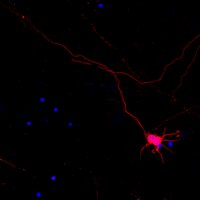O-GlcNAcylation regulates phosphorylation of tau: a mechanism involved in Alzheimer's disease.
Liu, Fei, et al.
Proc. Natl. Acad. Sci. U.S.A., 101: 10804-9 (2004)
2004
Abstract anzeigen
Microtubule-associated protein tau is abnormally hyperphosphorylated and aggregated into neurofibrillary tangles in brains of individuals with Alzheimer's disease (AD) and other tauopathies. Tau pathology is critical to pathogenesis and correlates to the severity of dementia. However, the mechanisms leading to abnormal hyperphosphorylation are unknown. Here, we demonstrate that human brain tau was modified by O-GlcNAcylation, a type of protein O-glycosylation by which the monosaccharide beta-N-acetylglucosamine (GlcNAc) attaches to serine/threonine residues via an O-linked glycosidic bond. O-GlcNAcylation regulated phosphorylation of tau in a site-specific manner both in vitro and in vivo. At most of the phosphorylation sites, O-GlcNAcylation negatively regulated tau phosphorylation. In an animal model of starved mice, low glucose uptake/metabolism that mimicked those observed in AD brain produced a decrease in O-GlcNAcylation and consequent hyperphosphorylation of tau at the majority of the phosphorylation sites. The O-GlcNAcylation level in AD brain extracts was decreased as compared to that in controls. These results reveal a mechanism of regulation of tau phosphorylation and suggest that abnormal hyperphosphorylation of tau could result from decreased tau O-GlcNAcylation, which probably is induced by deficient brain glucose uptake/metabolism in AD and other tauopathies. | 15249677
 |
Site-specific phosphorylation of tau accompanied by activation of mitogen-activated protein kinase (MAPK) in brains of Niemann-Pick type C mice.
Sawamura, N, et al.
J. Biol. Chem., 276: 10314-9 (2001)
2001
Abstract anzeigen
Niemann-Pick type C (NPC) disease is characterized by an accumulation of cholesterol in most tissues and progressive neurodegeneration with the formation of neurofibrillary tangles. Neurofibrillary tangles are composed of paired helical filaments (PHF), a major component of which is the hyperphosphorylated tau. In this study we used NPC heterozygous and NPC homozygous mouse brains to investigate the molecular mechanism responsible for tauopathy in NPC. Immunoblot analysis using anti-tau antibodies (Tau-1, PHF-1, AT-180, and AT-100) revealed site-specific phosphorylation of tau at Ser-396 and Ser-404 in the brains of NPC homozygous mice. Mitogen-activated protein kinase, a potential serine kinase known to phosphorylate tau, was activated, whereas other serine kinases such as glycogen synthase kinase-3beta and cyclin-dependent kinase 5 were inactive. Morphological examination demonstrated that a number of neurons, the perikarya of which strongly immunostained with PHF-1, exhibited polymorphorous cytoplasmic inclusion bodies and multi-concentric lamellar-like bodies. Importantly, the accumulation of intracellular cholesterol in NPC mouse brains was determined to be a function of age. From these results we conclude that abnormal cholesterol metabolism due to the genetic mutation in NPC1 may be responsible for activation of the mitogen-activated protein kinase-signaling pathway and site-specific phosphorylation of tau in vivo, leading to tauopathy in NPC. | 11152466
 |










